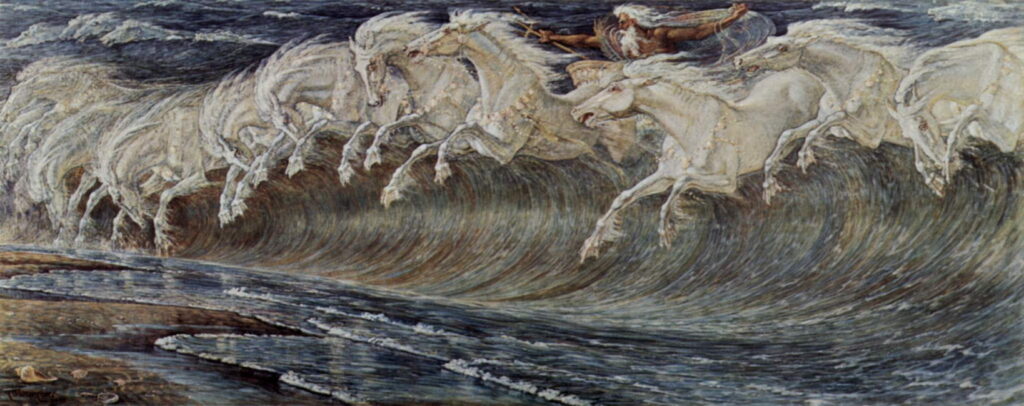Reading visual art: 148 The horse in myth and legend

Since its domestication somewhere on the steppe of Ukraine and south-western Russia around five millennia ago, humans have been dependent on the horse as a means of transport and drawing wheeled vehicles of many kinds. By the late eighteenth century the work they’re capable of was used as the basis for the measurement of power, in the horsepower, that became most popular when they were being replaced first by steam engines, and then the noisy and smelly motor vehicles of the twentieth century.
These two articles look at horses of conventional design; those with wings have been covered here, and the story of the unicorn in this article.
In Greek and Roman myth, the sun is drawn across the heavens by Phoebus’ chariot, with four horses, usually named Eous, Aethon, Pyrois, and Phlegon, in harness.
Gustave Moreau (1826–1898), The Chariot of Apollo, or Phoebus Apollo (c 1880), oil on canvas, 55.5 x 44.5 cm, Private collection. Wikimedia Commons.
They are shown in Gustave Moreau’s Chariot of Apollo, or Phoebus Apollo from about 1880, in a prelude to the myth of Phaethon, who lost control of it and set the world on fire when his adventure went wrong.
While several deities are drawn in their chariots by unusual creatures, Pluto opts for a pair of suitably black horses.
Walter Crane (1845–1915), The Fate of Persephone (1878), oil and tempera on canvas, 122.5 × 267 cm, Private collection. Wikimedia Commons.
Walter Crane’s account of The Fate of Persephone (1878) shows her at the moment of her abduction, still holding her posy. Pluto has pulled up in his chariot, and is gripping her right arm, ready to make off with her into the dark cavern to the right, taking the couple down to Hades.
Franz von Matsch (1861–1942), The Triumph of Achilles (1892), media and dimensions not known, Achilleion, Corfu, Greece. Wikimedia Commons.
Chariots of mortals were conventionally drawn by a pair of horses. Franz von Matsch’s The Triumph of Achilles (1892) shows Achilles in his chariot driving at speed around the walls of Troy, towing the naked body of Hector and followed by celebrating Greeks.
Troy was also the site of the greatest deception using a horse, although in this case it was a huge wooden model containing a team of Greek commandos who were to open the city up for the rest of their army to enter.
Giovanni Domenico Tiepolo (1727–1804), The Procession of the Trojan Horse in Troy (1773), oil on canvas, 39 x 67 cm, The National Gallery, London. Wikimedia Commons.
Tiepolo’s Procession of the Trojan Horse in Troy (1773) is one of his series showing the construction and entry of the horse into the city. He follows accounts that refer to Troy’s women and children hauling the structure using lines, and some reporting that it was ostensibly an apology for the theft of the Palladium.
Subsequently, the term Trojan Horse has entered the languages of Europe, although that isn’t the case for the Roman hero Marcus Curtius, whose leap saved the city of Rome.
Jean-Léon Gérôme (1824–1904), The Leap of Marcus Curtius (c 1850-1855), oil on canvas, 53.3 x 55.2 cm, Smith College Museum of Art, Northampton, MA. The Athenaeum.
Jean-Léon Gérôme’s Leap of Marcus Curtius (c 1850-1855) depicts the brief legend of this hero of classical Rome. Following an earthquake (now dated to 362 BCE), a great bottomless chasm opened up in the middle of the Forum. Attempts to fill it were unsuccessful, so an augur was consulted, who responded that the gods demanded the most precious possession of the state. Marcus Curtius was a young soldier who proclaimed that arms and the courage of Romans were the state’s most precious possessions. In a moment of supreme self-sacrifice, he then rode into the pit in his finest armour, astride his charger, the moment shown here. As he and his horse fell into its abyss, the chasm closed over him, and the city was saved.
Horses feature in many other legends from around the world. Among the more curious is that of Lady Godiva, who is claimed to have ridden naked through the streets of Coventry, England, in protest at her husband’s swingeing taxes.
Jules Lefebvre (1834–1912), Lady Godiva (1891), oil on canvas, 62 x 39 cm, Musée de Picardie, Amiens, France. Wikimedia Commons.
Jules Lefebvre’s first painting of Lady Godiva from 1891 shows her passing over deserted narrow cobbled streets, covering her breasts and appearing in some distress. Her horse is being led by a maid, and flying alongside are three white doves. She appears almost saintly in her mission, as if undergoing a form of psychological martyrdom.
Walter Crane (1845–1915), Neptune’s Horses (1892), oil on canvas, 33.9 × 84.8 cm, Neue Pinakothek, Munich, Germany. Wikimedia Commons.
Walter Crane’s Neptune’s Horses from 1892 is one of a series of paintings he made fusing the horses drawing Poseidon’s chariot with near-breaking waves, popularly known in English as white horses.
Another widespread legend is that of Saint George, a knightly Christian who slayed a dragon to save a princess. He is claimed by several countries across Europe as far as Georgia, and is patron saint of England.
Tintoretto (1519–1594), Saint George and the Dragon (c 1555) (E&I 62), oil on canvas, 158.3 x 100.5 cm, The National Gallery, London. Wikimedia Commons.
Around 1553-55, Tintoretto retold his story in his small masterpiece of Saint George and the Dragon. The saint, the dragon and the Princess have escaped the confines of his earlier votive painting of this motif, and here run free in a rich green coastal landscape of the artist’s invention. George is locked in battle with the dragon and the Princess flees from the scene in terror. The dragon’s last victim still lies on the grass, his blue clothing in tatters. Above them and the massive walls of a distant fortress is the figure of God, in a brilliant mandorla in the heavens.
That leads us to tomorrow’s sequel, which starts with horses in chivalry.



